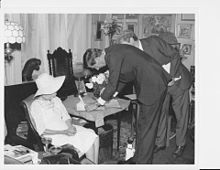Esther Lape

Esther Lape (8 October 1881–17 May 1981) was a well-known American journalist, researcher, and publicist. She was associated with the Women's Trade Union League[1] and was one of the founders of the League of Women Voters.
Her life-partner, Elizabeth Read, was her personal attorney and financial advisor.[2]
Career
Esther Lape taught English at Swarthmore College, the University of Arizona, Columbia University, and Barnard College.[3][4]
She was an activist of the Women's Trade Union League and one of the founders of the League of Women Voters.[3]
Lape was the director of the American Foundation for Studies in Government of which her partner, Elizabeth Fisher Read, was director of research.[4][5][6][7]
In the 1920s and 1930s she led an unsuccessful battle for United States participation in the World Court.[4]
Lape edited a book on expert medical testimony, Medical Research: A Midcentury Survey (1955), sponsored by the American Foundation.[3][5][6][7] In 1923 she collaborated with Read and Gustav Frenssen to Klaus Hinrich Baas: The Story Of A Self-made Man....[8] Together with Read, Lape published the journal City, State and Nation.[3]
Personal life
Esther Everett Lape was born on October 8, 1881 in Wilmington, Delaware.[9] She attended public school in Philadelphia, then Bryn Mawr College and Wellesley College.[4] Esther Lape lived with Elizabeth Fisher Read, Women's Suffrage activist and Eleanor Roosevelt's lawyer and friend, in Greenwich Village, at 20 East 11th Street, where today a plaque said Eleanor Roosevelt lived here when she was first lady.[7] The building was actually owned by Lape.[10] Roosevelt, who had met Lape through Read in 1920, rented an apartment for a time.[3][5][11] Nearby, at 171 West 12th Street, lived other lesbian couples involved in the Woman's Suffrage movement and of the close-knit circle of friends of Roosevelt: Marion Dickerman and Nancy Cook, Molly Dewson and Polly Porter, Grace Hutchins and Anna Rochester.[10] Lape, with her life partner, Read, and other Roosevelt's female friends, was part of Roosevelt's support network of female friends.[5]

Lape and Read also owned a country house, Salt Meadow, Westbrook, Connecticut, where Roosevelt was often a guest.[5][7] In 1972, after Read's death, Lape donated Salt Meadow to the U.S. Fish and Wildlife Service. The estate is currently the Stewart B. McKinney National Wildlife Refuge.[6] Refuge staff are working on a submission for National Register of Historical Places recognition for the former Salt Meadow estate that will recognize the same-sex relationship of Lape and Read.[12]
Esther Everett Lape died on May 17, 1981, in New York City, at 99 years old.[3][4]
References
- ^ "Women's Trade Union League".
- ^ "Teaching Eleanor Roosevelt Glossary".
- ^ a b c d e f "Esther Lape (1881-1981)". The Eleanor Roosevelt Papers Project. Retrieved 6 January 2018.
- ^ a b c d e BARBANEL, JOSH (1981). "ESTHER LAPE, 100, SOCIAL SCIENTIST; FAVORED U.S. ROLE IN WORLD COURT". The New York Times. Retrieved 6 January 2018.
- ^ a b c d e "Elizabeth Fisher Read (1872-1943)". The Eleanor Roosevelt Papers Project. Retrieved 5 January 2018.
- ^ a b c "Esther Lape and Elizabeth Read: Pioneers for Women's Rights and Conservation". U.S. Fish & Wildlife Service. 2016-03-21. Retrieved 5 January 2018.
- ^ a b c d "Village People: Elizabeth Fisher Read and Esther Lape". Greenwich Village Society for Historic Preservation. 2014-12-19. Retrieved 5 January 2018.
- ^ Frenssen, Gustav; Lape, Esther Everett; Read, Elizabeth Fisher (1923). Klaus Hinrich Baas: The Story Of A Self-made Man... ISBN 1271814374.
- ^ "Esther Lape (1881-1981)".
- ^ a b Cook, Blanche Wiesen (1993). Eleanor Roosevelt, Volume 1: The Early Years, 1884-1933. Penguin. p. 310. ISBN 9781101567463. Retrieved 5 January 2018.
- ^ "Eleanor Roosevelt Residence". NYC LGBT Historic Sites Project. Retrieved 5 January 2018.
- ^ "LGBTQ America" (PDF). nps. Retrieved 5 January 2018.
 This article incorporates text from this source, which is in the public domain.
This article incorporates text from this source, which is in the public domain.
